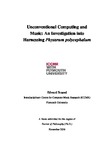Unconventional Computing and Music: An Investigation into Harnessing Physarum polycephalum
| dc.contributor.supervisor | Miranda, Eduardo | |
| dc.contributor.author | Braund, Edward | |
| dc.contributor.other | Faculty of Arts, Humanities and Business | en_US |
| dc.date.accessioned | 2017-03-16T15:47:57Z | |
| dc.date.issued | 2017 | |
| dc.identifier | 10235263 | en_US |
| dc.identifier.uri | http://hdl.handle.net/10026.1/8652 | |
| dc.description.abstract |
This thesis presents an investigation into developing musical systems with an Unconventional Computing substrate. Computer musicians have found it difficult to access the field of Unconventional Computing, which is likely due to its resource-intensive and complex nature. However, ongoing research is establishing the myxomycete Physarum polycephalum as a universally-accessible and versatile biological computing substrate. As such, the organism is a potential gateway for computer musicians to begin experimenting with aspects of Unconventional Computing. Physarum polycephalum, in its vegetative plasmodium form, is an amorphous unicellular organism that can respond with natural parallelism to the environmental conditions that surround it. This thesis explores the challenges and opportunities related to developing musical systems with Physarum polycephalum. As this area of inquiry is in its infancy, the research took inspiration from a common approach in Unconventional Computing: a journey of exploration and discovery. This journey consisted of a selection of waypoints that provided direction while allowing the research to explore applications of Physarum polycephalum in order to establish how it may be useful in Computer Music. These waypoints guided the research from adapting established prototypes for musical application to developing purpose-made musical demonstrators for use outside of the laboratory. Thus, the thesis reports on a series of Computer Music systems that explore one or more features of Physarum polycephalum's behaviour and physiology. First, the text presents an approach to algorithmic composition that exploits the organism's ability to form and reconfigure graph-like structures. Next, the thesis reports on systems that harness the plasmodium's electrical potential oscillations for sound synthesis and compositional tools. Finally, the thesis presents musical devices that encompass living plasmodium as electrical components. Where applicable, the thesis includes artefacts from demonstrations of these systems, some of which were developed in collaboration with a composer. The findings from this journey demonstrate that Physarum polycephalum is an appropriate substrate for computer musicians wanting to explore Unconventional Computing approaches creatively. Although Physarum polycephalum is relatively robust as a biological substrate, several obstacles arose during this project. This research addressed such obstacles by reviewing and selecting approaches that maintained the organism's accessibility to computer musicians. As a result, the work suggests methods for developing systems with the organism that are practical for the average music technologist and also beneficial to the wider group of scientists investigating Physarum polycephalum for other purposes. | en_US |
| dc.description.sponsorship | Plymouth University HumPA Studentship | en_US |
| dc.language.iso | en | |
| dc.publisher | University of Plymouth | |
| dc.rights | Attribution-NonCommercial-NoDerivs 3.0 United States | * |
| dc.rights.uri | http://creativecommons.org/licenses/by-nc-nd/3.0/us/ | * |
| dc.subject | Computer Music | en_US |
| dc.subject | Unconventional Computing | en_US |
| dc.subject | Music | en_US |
| dc.subject | Physarum polycephalum | en_US |
| dc.subject | Memristor | en_US |
| dc.subject | Music Technology | en_US |
| dc.subject.classification | PhD | en_US |
| dc.title | Unconventional Computing and Music: An Investigation into Harnessing Physarum polycephalum | en_US |
| dc.type | Thesis | |
| plymouth.version | publishable | en_US |
| dc.identifier.doi | http://dx.doi.org/10.24382/415 | |
| dc.rights.embargodate | 2018-03-16T15:47:57Z | |
| dc.rights.embargoperiod | 12 months | en_US |
| dc.type.qualification | Doctorate | en_US |
| rioxxterms.version | NA |
Files in this item
This item appears in the following Collection(s)
-
01 Research Theses Main Collection
Research Theses Main



